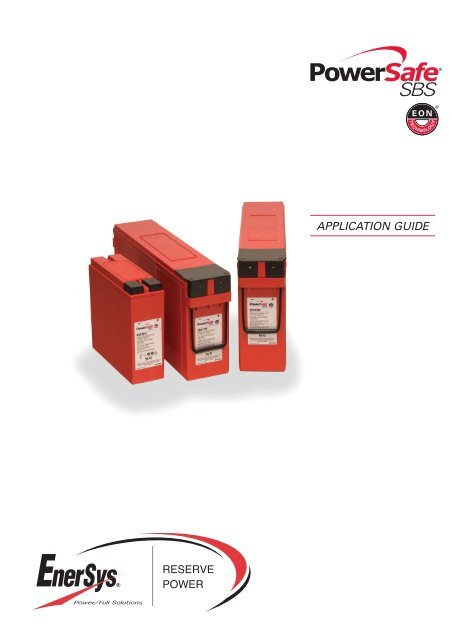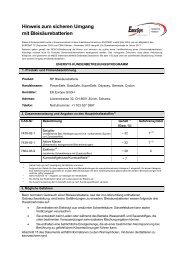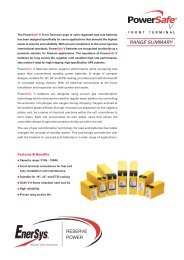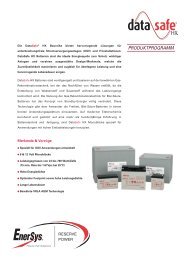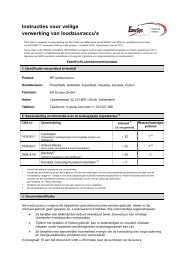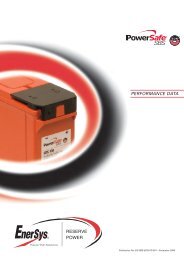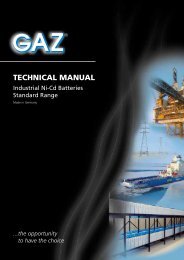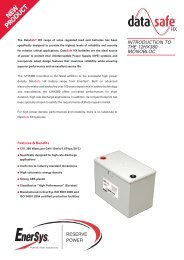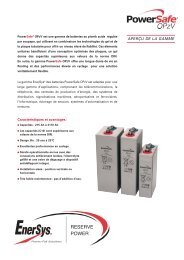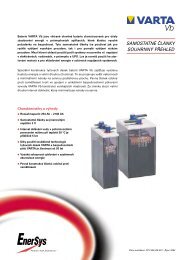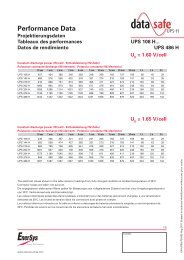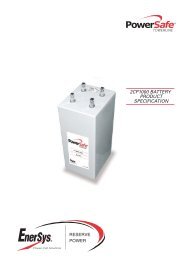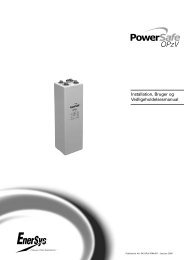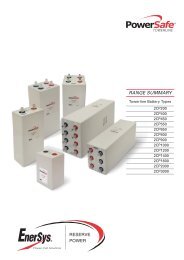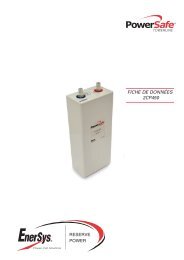EN-SBS-EON-AG-004 - Enersys - EMEA
EN-SBS-EON-AG-004 - Enersys - EMEA
EN-SBS-EON-AG-004 - Enersys - EMEA
You also want an ePaper? Increase the reach of your titles
YUMPU automatically turns print PDFs into web optimized ePapers that Google loves.
RESERVE<br />
POWER<br />
APPLICATION GUIDE
2<br />
EnerSys ® has optimised the very successful Thin Plate Pure Lead<br />
(TPPL) PowerSafe ® <strong>SBS</strong> battery range to create the revolutionary <strong>EON</strong><br />
Technology ® , a new concept that utilises highest purity materials and<br />
state of the art manufacturing processes to deliver energy storage<br />
solutions that can meet the requirements of emerging applications<br />
whilst offering the end user enhanced performance in existing<br />
applications. Historically, the useful service life of reserve power<br />
Valve Regulated Lead Acid (VRLA) battery systems was measured by<br />
their float life but as applications evolve from pure standby to cyclic<br />
applications, some traditional VRLA technologies find that these new<br />
requirements push them beyond their scope of operation.<br />
PowerSafe <strong>SBS</strong> Eon Technology batteries retain the long float<br />
characteristics of standard PowerSafe <strong>SBS</strong> cells and monoblocs, with<br />
the added benefit of improved cyclic ability in both float voltage and<br />
fast charge applications.<br />
Interchangeability<br />
PowerSafe <strong>SBS</strong> <strong>EON</strong> Technology monoblocs are fully interchangeable<br />
with standard PowerSafe <strong>SBS</strong> battery equivalents (where applicable).<br />
When used in conventional float applications the fit, form and<br />
function remain unchanged and their mixing will have no detrimental<br />
effect to either the performance or expected service life. However,<br />
where a PowerSafe <strong>SBS</strong> <strong>EON</strong> Technology monobloc is introduced as<br />
a replacement into an equivalent standard PowerSafe <strong>SBS</strong> battery it<br />
must be understood that the improved cyclic capability afforded by<br />
<strong>EON</strong> Technology will not be achieved.<br />
Operating Temperature Range<br />
The recommended operating temperature range for optimum life and<br />
performance is 20°C. However, PowerSafe <strong>SBS</strong> <strong>EON</strong> Technology<br />
batteries can be operated in the temperature range -40°C to +50°C.<br />
In order to maintain mechanical integrity of the plastic components,<br />
the battery temperature in operation should not exceed +50°C.<br />
Storage<br />
Batteries lose capacity when standing on open-circuit because of<br />
parasitic chemical reactions. The self-discharge rate of PowerSafe<br />
<strong>SBS</strong> <strong>EON</strong> Technology monoblocs is very low because of the high<br />
purity of the grid lead and electrolyte. Batteries should be stored in a<br />
cool, dry area. High temperature increases the rate of self-discharge<br />
and reduces storage life.<br />
Figure 1 shows the relationship between open-circuit voltage (OCV)<br />
and storage time at various temperatures.<br />
2.17<br />
100<br />
2.16<br />
96<br />
2.15<br />
91<br />
2.14<br />
87<br />
2.13<br />
83<br />
2.12<br />
79<br />
2.11<br />
2.10<br />
+40°C +30°C +25°C +20°C +10°C<br />
74<br />
70<br />
0 6 12 18 24 30 36 42 48<br />
Figure 1<br />
Months<br />
Open Circuit Voltage per Cell<br />
The maximum storage times before a freshening charge is required<br />
and recommended open circuit voltage audit intervals are:<br />
Temperature Storage Time OCV Audit Interval<br />
(°C / °F) (Months) (Months)<br />
+10 / +50 48 6<br />
+15 / +59 34 6<br />
+20 / +68 24 4<br />
+25 / +77 17 4<br />
+30 / +86 12 3<br />
+35 / +95 8.5 2<br />
+40 / +104 6 2<br />
Monoblocs must be given a freshening charge when bloc voltages<br />
approach the equivalent of 2.10 Volts per cell or when the maximum<br />
storage time is reached, whichever occurs first.<br />
Approx. State of Charge (%)<br />
Commissioning Charge<br />
Before conducting a capacity discharge or fully loaded duty cycle test,<br />
the battery must be given a commissioning charge. In float<br />
applications the commissioning charge shall consist of 7 continuous<br />
days of float charge at the recommended float voltage (2.29Vpc at<br />
20°C) with no load connected to the battery. In hybrid applications the<br />
commissioning charge shall consist of 24 hours charge at a voltage<br />
equivalent to 2.40 Volts/cell with no load connected.<br />
Freshening Charge<br />
Charge the monoblocs or strings at a constant voltage equivalent<br />
to 2.29 to 2.4Vpc with 0.1C10 Amps current for a period of 24 hours.<br />
Float Operation<br />
<strong>EON</strong> Technology is designed for continuous float operation on<br />
constant voltage chargers. Constant voltage charging is the safest,<br />
most efficient and recommended method of charging VRLA batteries.<br />
The recommended float voltage setting is 2.29Vpc at +20°C/+77°F.<br />
Therefore the system voltage setting equals the number of cells in<br />
series x 2.29Vpc.<br />
Battery life and charging characteristics are affected by temperature.<br />
Optimum battery life will be achieved when the battery is operating<br />
between +20°C/+68°F and +25°C/+77°F (see figure 2).<br />
Float Life<br />
(Float @ 55°C using recommended FV for 20°C)<br />
120<br />
110<br />
100<br />
90<br />
80<br />
70<br />
60<br />
50<br />
40<br />
30<br />
20<br />
10<br />
0<br />
0 1 2 3 4 5 6 7 8 9 10 11 12 13 14 15 16 17<br />
Figure 2<br />
Calculated Life (years @ 20°C)<br />
Nominal Capacity (%)<br />
Battery life is reduced by 50% for every 10°C/18°F increase in<br />
temperature. Float voltage compensation reduces the charging<br />
current as battery temperature increases and partially negates the<br />
adverse effect of high temperature.<br />
The recommended float voltage temperature compensation is:<br />
• 2.29Vpc +4mV per cell per °C below 20°C<br />
• 2.29Vpc -4mV per cell per °C above 20°C (refer to figure 3 for further<br />
details)<br />
Temperature compensation is capped at +40°C/+104°F as at this<br />
temperature the compensated charge voltage approaches the natural<br />
open circuit voltage of the battery and there is insufficient<br />
overvoltage to keep the battery in a fully charged condition.<br />
Float Volts Per Cell<br />
2.35<br />
2.34<br />
Recommended Float Voltage<br />
2.33<br />
2.32<br />
Minimum Float Voltage<br />
2.31<br />
2.30<br />
Voltages > Recommended promote<br />
2.29<br />
overcharge & high float currents resulting<br />
2.28<br />
in accelerated end of service life<br />
2.27<br />
2.26<br />
2.25<br />
2.24 Voltages < Minimum recommended<br />
2.23 result in undercharge, reduction in<br />
2.22 capacity and irrecoverable capacity<br />
2.21 loss leading to premature end of life<br />
2.20<br />
2.19<br />
10 11 12 13 14 15 16 17 18 19 20 21 22 23 24 25 26 27 28 29 30 31 32 33 34 35 36 37 38 39 40 41 42<br />
Figure 3<br />
Float Voltage Temperature Correction<br />
Temperature (°C)<br />
Charging Current<br />
Recharge time is a function of the charging voltage and current.<br />
In float applications where time to repeat duty is not so critical to<br />
recharge in an acceptable time it is recommended that the current<br />
limit should be a minimum level equalling the standing load plus<br />
0.1C10 Amps.
Fast Charging<br />
In addition to the long life characteristics inherent in traditional<br />
PowerSafe ® <strong>SBS</strong> TPPL battery designs, <strong>EON</strong> Technology ® has been<br />
developed to provide high performance in applications where the<br />
battery is subjected to repeated cyclic duty, where power reliability<br />
is tested by high temperatures and harsh conditions, combined with<br />
remote locations.<br />
Fast charge techniques are best utilised for frequent discharge cyclic<br />
applications. The high charge acceptance of <strong>EON</strong> Technology is<br />
suited for applications which require a faster recharge with reduced<br />
time to repeat duty. In such applications the rectifier voltage should<br />
be set at 2.40Vpc at 20°C. Figure 4 illustrates the time to full state of<br />
charge from varying depths of discharge (C10) as a function of charge<br />
voltage.<br />
Recharge Time to 100% State of Charge following C10 Discharge<br />
to Varying Depth of Discharge.<br />
Compare Float Charge with <strong>EON</strong> Technology<br />
110<br />
100<br />
90<br />
80<br />
70<br />
60<br />
50<br />
40<br />
30<br />
<strong>EON</strong> Technology Fast Charge FV Recharge<br />
20<br />
10<br />
0<br />
0 2 4 6 8 10 12 14 16<br />
Time to 100% State of Charge (hrs)<br />
® Recharge Regime<br />
(current limit 25% C10)<br />
Figure 4<br />
% Depth of Discharge (C10)<br />
As with float charge, temperature compensation for voltage is<br />
applicable to fast charge techniques. The profile below (figure 5)<br />
gives the recommended compensation to charge voltage for<br />
temperature.<br />
Volts Per Cell<br />
Fast Charge Temperature Correction<br />
2.53<br />
2.51<br />
2.49<br />
2.47<br />
2.45<br />
2.43<br />
2.41<br />
2.39<br />
2.37<br />
2.35<br />
2.33<br />
2.31<br />
2.29<br />
2.27<br />
2.25<br />
10 15 20 25 30 35 40 45 50<br />
Temperature (°C)<br />
Figure 5<br />
In cyclic applications, optimal life and performance are obtained by<br />
limiting recharge at 2.40Vpc to the time taken to return 103% of<br />
discharged Ah before disconnecting the battery from the rectifier or<br />
switching to float voltage. In systems where control of charge factor<br />
is not possible, the battery will be returned to full state of charge<br />
(from 100% depth of discharge C10) in 6.5 hours at 2.40Vpc with<br />
0.25C10 Amps available. Higher charge currents will reduce charge<br />
time, lower currents will increase charge time.<br />
Where rectifier voltage cannot be adjusted to values >2.40Vpc to<br />
compensate for lower temperatures, the time to reach full state of<br />
charge will be increased. For additional information and guidance on<br />
this, please contact your EnerSys ® representative.<br />
Warning! Continuous charge at 2.40Vpc will significantly reduce battery<br />
life.<br />
Current Limit<br />
In addition to the influence of charge voltage, the available charge<br />
current will impact on time to repeat duty. The low internal resistance<br />
of PowerSafe <strong>SBS</strong> <strong>EON</strong> Technology batteries lends itself to<br />
absorption of in rush currents as high as 6C10 Amps but is equally<br />
capable of operating with current limits as low as 0.1C10 Amps.<br />
Figure 6 below illustrates the typical time to full state of charge<br />
(2.40Vpc) as a function of available charge current from varying<br />
depths of discharge.<br />
Time (hrs)<br />
0<br />
0% 10% 20% 30% 40% 50% 60% 70% 80% 90% 100% 110%<br />
Figure 6<br />
Depth of Discharge<br />
Cycling<br />
<strong>EON</strong> Technology has been developed to retain the long float life<br />
characteristics associated with standard PowerSafe <strong>SBS</strong> technology<br />
and has the added capability to deliver high performance in harsh<br />
applications where cyclic duty predominates.<br />
Extensive testing has shown that in traditional float cyclic<br />
applications PowerSafe <strong>SBS</strong> <strong>EON</strong> Technology surpasses the excellent<br />
performance of standard PowerSafe <strong>SBS</strong> battery designs, typically<br />
delivering a 33% increase in the number of cycles during evaluation<br />
to international benchmark standards (figure 7).<br />
Cycle Life vs Depth of Discharge,<br />
Compare Float Charge (PowerSafe ® <strong>SBS</strong> & <strong>SBS</strong> <strong>EON</strong> Technology ® )<br />
Number of Cycles<br />
10000<br />
1000<br />
<strong>SBS</strong> <strong>EON</strong> Float Charge<br />
<strong>SBS</strong> Float Charge<br />
100<br />
0 10 20 30 40 50 60 70 80 90 100 110 120<br />
Figure 7<br />
Depth of Discharge<br />
Where it is not always economically viable to use higher charge<br />
currents it has been demonstrated that increasing the charge voltage<br />
at a given current limit, the time to full state of charge can be<br />
radically reduced.<br />
The electrochemical designs of PowerSafe <strong>SBS</strong> <strong>EON</strong> Technology<br />
batteries have been developed to take advantage of this<br />
characteristic. The low internal resistance ensures that PowerSafe<br />
<strong>SBS</strong> <strong>EON</strong> Technology batteries can operate with charge current limits<br />
ranging from 0.1C10 Amps to 6C10 Amps affording a high degree of<br />
operating flexibility encompassing a wide range of operating<br />
scenarios. It should be remembered that lower current limits increase<br />
time to full state of charge, regardless of charge voltage (shown in<br />
figure 8 below).<br />
Effect of Charge Voltage on Recharge Time to 100% of Discharge Ah.<br />
2.29Vpc vs 2.4Vpc following 100% DOD at various rates.<br />
Current limit 0.4C10 Amps<br />
Time to 100% of DCH Ah Returned<br />
18<br />
16<br />
14<br />
12<br />
10<br />
8<br />
6<br />
4<br />
2<br />
9<br />
8<br />
7<br />
6<br />
5<br />
4<br />
3<br />
2<br />
1<br />
0<br />
Figure 8<br />
Time to Full State of Charge<br />
As a Function of Current Limit and Depth of Discharge<br />
(Recharge 2.40Vpc)<br />
0.1C10 Amps<br />
0.2C10 Amps<br />
0.3C10 Amps<br />
0.5C10 Amps<br />
1C10 Amps<br />
2.27Vpc 2.4Vpc<br />
C1 C3<br />
Discharge Rate<br />
C10<br />
0.1C10A<br />
0.2C10A<br />
0.3C10A<br />
0.5C10A<br />
1.0C10A<br />
The high charge acceptance of PowerSafe <strong>SBS</strong> <strong>EON</strong> Technology<br />
batteries that enables the use of fast charge techniques provides the<br />
user with the advantage of reduced time to repeat duty and further<br />
extends the number of cycles available during service life to<br />
unparalleled levels (figure 9).<br />
3
Figure 9<br />
PowerSafe ® <strong>SBS</strong> <strong>EON</strong> Technology ®<br />
Cycle Life as a Function of Depth of Discharge (C10 Rate)<br />
(Charge Using Optimum <strong>EON</strong> Technology Recommendations)<br />
Maintenance<br />
In practice the user usually specifies the maintenance schedule based<br />
on site criticality, location and manpower.<br />
The following is a suggested maintenance schedule.<br />
• Monthly (record all readings)<br />
Measure the battery string voltage. If necessary, adjust the float<br />
voltage to the correct value.<br />
• Every six months (record all readings)<br />
Measure the battery string voltage. If necessary, adjust the float<br />
voltage to the correct value.<br />
Measure individual bloc voltages. The blocs should be within 5% of<br />
the average.<br />
Inspect for contamination by dust, loose or corroded connections.<br />
If necessary isolate the string/bloc and clean with a damp soft cloth.<br />
Do not use solvents or scouring powders to clean the blocs.<br />
Contact EnerSys ® if you have any questions regarding maintenance.<br />
Disposal<br />
PowerSafe ® <strong>SBS</strong> <strong>EON</strong> Technology ® batteries are recyclable. Scrap<br />
batteries must be packaged and transported in accordance with<br />
prevailing transportation rules and regulations. Scrap batteries must<br />
be disposed of in compliance with local and national laws by a<br />
licensed or certified lead acid battery recycler.<br />
General Specifications<br />
www.enersys-emea.com<br />
Nominal Capacity (Ah) Nominal Dimensions<br />
Connectors<br />
PowerSafe ® <strong>SBS</strong><br />
Battery Type<br />
Contact:<br />
Connector Part No.<br />
<strong>SBS</strong> B14, C11 2205-8919<br />
<strong>SBS</strong> B14F, C11F 2205-8891<br />
<strong>SBS</strong> 100 2205-8750<br />
<strong>SBS</strong> 100F 2205-8749<br />
<strong>SBS</strong> 170F & 190F 2205-8769<br />
<strong>SBS</strong> 410 2205-9887 (A)<br />
<strong>SBS</strong> 410 2205-8865 (B)<br />
<strong>SBS</strong> B14, C11, 100<br />
A<br />
<strong>SBS</strong> 410<br />
B<br />
<strong>SBS</strong> B14F, C11F, 100F,<br />
170F, 190F<br />
PowerSafe ® <strong>SBS</strong> 10 hr rate 8 hr rate Typical Internal<br />
Battery Nominal to 1.80Vpc to 1.75Vpc Length Width Height Weight Short Circuit Resistance Terminals<br />
Type Voltage (V) @ 20°C @ 77°F mm in mm in mm in kg lbs Current (A) (mΩ)<br />
<strong>SBS</strong> B14 12 62 62 280 11.0 97 3.8 264 10.4 19.1 42.0 1800 7.0 M8 F<br />
<strong>SBS</strong> B14F 12 62 62 303 11.9 97 3.8 264 10.4 19.1 42.0 1800 7.0 M6 M<br />
<strong>SBS</strong> C11 12 92 91 395 15.6 105 4.1 264 10.4 28.0 61.6 2300 5.5 M8 F<br />
<strong>SBS</strong> C11F 12 92 91 417 16.4 105 4.1 256 10.1 28.0 61.6 2300 5.5 M6 M<br />
<strong>SBS</strong> 100 12 100 100 395 15.6 108 4.3 287 11.3 32.6 71.9 2210 5.6 M8 F<br />
<strong>SBS</strong> 100F 12 100 100 395 15.6 108 4.3 287 11.3 32.6 71.9 2210 5.6 M6 M<br />
<strong>SBS</strong> 170F 12 170 170 561 22.1 125 4.9 283 11.1 52.5 115.7 3400 4.0 M6 M<br />
<strong>SBS</strong> 190F 12 190 190 561 22.1 125 4.9 316 12.4 60.0 132.3 3800 3.3 M6 M<br />
<strong>SBS</strong> 410 2 410 410 200 7.9 208 8.2 239 9.4 23.2 51.1 4725 1.3 M8 M<br />
EnerSys<br />
P.O. Box 14145<br />
Reading, PA 19612-4145<br />
USA<br />
Tel: +1-610-208-1991<br />
+1-800-538-3627<br />
Fax: +1-610-372-8613<br />
EnerSys Europe<br />
Löwenstrasse 32<br />
8001 Zurich, Switzerland<br />
EnerSys Asia<br />
152 Beach Road<br />
Gateway East Building, Level 11<br />
189721 Singapore<br />
Tel. +65 6508 1780<br />
EnerSys Ltd.<br />
Oak Court<br />
Clifton Business Park<br />
Wynne Avenue, Swinton<br />
Manchester M27 8FF<br />
UK<br />
Tel: +44 (0)161 794 4611<br />
Fax: +44 (0)161 727 3809<br />
© 2011 EnerSys. All rights reserved.<br />
Trademarks and logos are the property of<br />
EnerSys and its affiliates unless otherwise noted.<br />
Publication No: <strong>EN</strong>-<strong>SBS</strong>-<strong>EON</strong>-<strong>AG</strong>-<strong>004</strong> - April 2011 - Subject to revisions without prior notice. E.&O.E.


